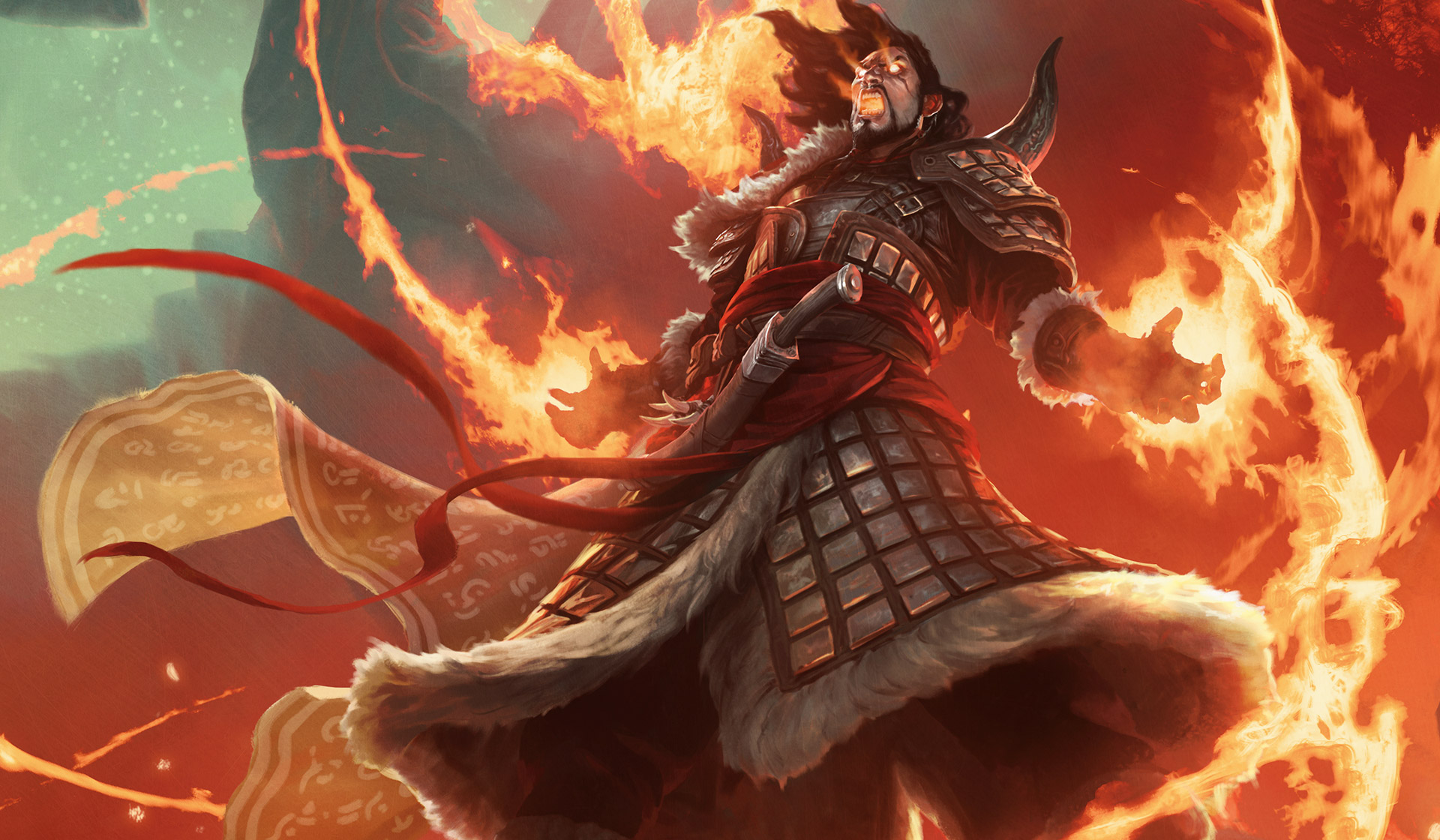
(All art copyright 2015 Wizards of the Coast unless otherwise noted.)
by Harry Huberty and Christina Ladd
Hello and welcome to the inaugural installment of Spells and Whistles! In this column, we’ll be taking a look at the art and flavor of Magic: The Gathering (and other assorted fantasy and gaming media), through two different lenses: first, through the eyes of an avid Magic player, and second, though the eyes of his cranky girlfriend.
Harry: I’m Harry, and I’ll be your avid Magic player for this column. I’ve been a Magic player for almost twenty years (yikes!), with a short break during Masques, Invasion, Onslaught, and Odyssey. High school was a difficult time.
Christina: I’m Christina, and I play Magic very casually, though I’m an avid participant in other parts of nerd culture. I’m also interested in how nerd culture represents gender, race, sexuality, and so on, so that’s what you’ll be getting from me.
Harry: We’ve got a lot to talk about in our first week. Magic’s newest expansion, Fate Reforged, which dropped last week. If you’re an avid Magic Player (that is: me), you already got a chance to play with the new cards this past weekend at the prerelease tournaments.
Fate Reforged moves the story of the current block, Khans of Tarkir, 1200-odd years into the past. In Khans, we met Tarkir’s five warring clans, each with their own distinct styles and philosophies, each representing a different combination of Magic’s five colors. In Fate, we see those same clans a thousand years earlier. They have different leaders, but the basic elements of their philosophies are still in place.
Five new khans means five new characters to discuss, so this week we’re welcoming Fate Reforged by talking about the art and aesthetics of Tarkir’s five new (past) clan leaders. Let’s jump in!
Shu Yun, the Silent Tempest
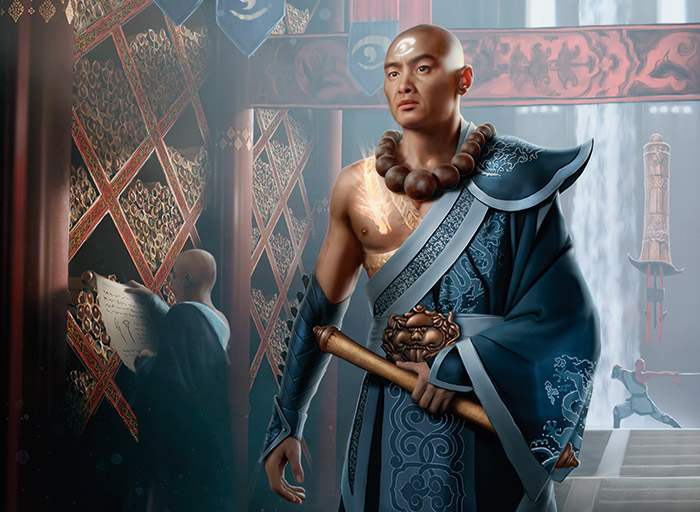
(Art by David Gaillet)
H: Shu Yun is the Khan of the Jeskai Way, who are the Crouching-Tiger-Hidden-Dragon wu shu monks of Tarkir. What I love about him: he’s a dead ringer for Chow Yun Fat.
This art is well composed, and the background images help to tie the major Jeskai flavor elements together: the pursuit of knowledge on the left of the image, and martial training on the right. The Jeskai, as befits the color blue, seek perfection of both the mind and the body, so it’s nice to see those ideas incorporated in their leader’s card art.
On the other hand, I can’t stand the dragon motifs on Shu Yun’s robes. And this is going to sound nitpicky—I did just say that I liked a Chinese character depicted in American fantasy art. But those are plainly, Chinese dragon motifs on his clothing, and on his tattoo. And for that, I have a few quibbles.
First, there are dragons on Tarkir right now, which are depicted on card art, and none of them look anything like the dragons on his clothing. And second, those dragons are actively trying to destroy him, raze his monastery, and kill everyone in the clan he leads.
Now, let’s be fair. The flavor text on other cards indicates that Shu Yun admires the dragons for their higher awareness and understanding, so I can see that he would want to honor them on his clothing. But if that’s the case, why memorialize a dragon that looks nothing like Ojutai? And if this dragon motif is supposed to be iconic, why make it look nothing like any dragon you’ve ever seen?
Dragon motifs in Chinese art took hundreds of years to become standardized. I get that you want to go for something iconic when you want to represent dragons on clothing, but this visual reference disrupts the fantasy universe Wizards is trying to create, because it appeals directly to our visual vocabulary.
So this art gets big points for representing a character type you wouldn’t see on any other fantasy property, but the visual references here fall short.
C: I’m likewise pleased to see Asian representation on a card, especially a strong and attractive Asian man. Even better, we see a little gender parity here with the casual display of his arm and pectoral, also seen on the background scholar and martial artist. That kind of display of skin isn’t functionally necessary, so we can assume that it’s meant to be aesthetically appealing. After endless boob windows (see: Vizkopa Guildmage, Teysa) and slit skirts (see: all Liliana ever), it’s nice to see a man showing some unnecessary skin.
Though I doubt this was intended by the artist, revealing one pectoral is also very evocative of the way that Amazons (Greek female warriors) are represented, since in legend they were said to have removed one breast in order to become better archers. It’s a good, gender-bending touch for the art history nerds out there.
That necklace, though. I don’t think you need to demonstrate so obviously that you’ve got the biggest balls, Shu Yun.
Daghatar the Adamant
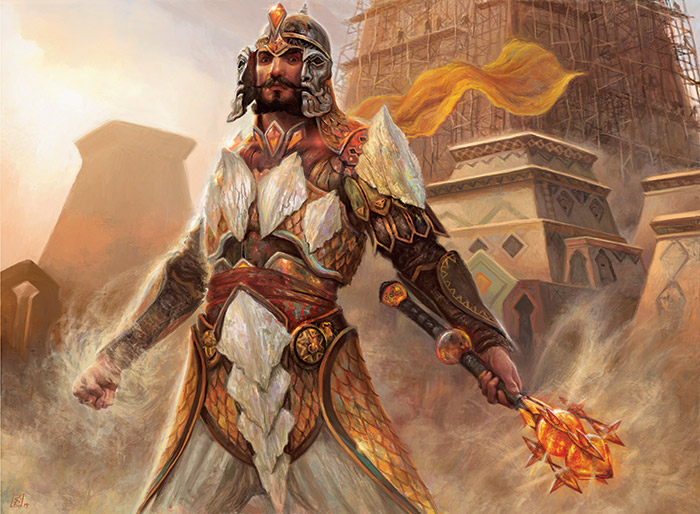
(Art by Zack Stella)
H: Daghatar is the khan of the Abzan, the clan which emphasizes kinship unity, self-defense, and endurance.
This image hits a bunch of those elements. There are solid buildings behind Daghatar, and scaffolding on the largest—erecting these houses is a community effort. On the whole, I was underwhelmed. But then I took a closer look at his faceplate.
It’s got a very Persian feel to it, like something you’d see in 300. (“Great,” I think. “Zach Snyder has ruined something else I love.”) Here the riff off real-world styles doesn’t bug me like it did with Shu Yun, since the iconography is of Daghatar himself, not based off a type of dragon which doesn’t appear in Tarkir.
Iconographically, it’s a great fit: it’s a war mask, but also a death mask. In the latter sense, it represents the Abzan, lasting forever, even beyond death. And with the faceplate open, you see Daghatar’s face in the center, but two more half-faces to either side—like his Abzan kin, always near him.
In other words, his faceplate manages to capture both the endurance and the kinship ties of the Abzan in one succinct visual. That’s a lot of weight for one image to pull.
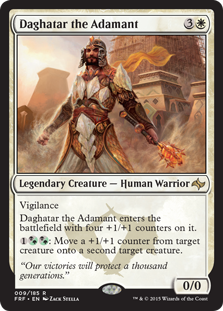
Mechanically, there’s not a lot of connections—maybe the four scales on his chest are the four +1/+1 counters?—but they can’t all be home runs. This is solid art as far as I’m concerned.
C: This is by far my favorite art out of the five from a purely aesthetic standpoint. The mask is extraordinarily effective not only in drawing together the themes of the clan, but also in immediately mythologizing the man. You don’t have to know who this is to feel his authority flowing from his eyes and from the empty sockets of the mask. That blend of the raw and the polished is evident all over the rest of the card, too, with the unembellished dragon scales standing out against the delicate work of his armor, and the painting on the ziggurats contrasting with their solid, unshakable shape.
Harry pointed out that Daghatar’s mace is probably amber, which is exactly the right kind of material and design for someone with such opulent status. I’ve never seen anything like it, and it looks as beautiful as it does wickedly effective. (But again—what’s with the giant balls here? Does everyone in this set have an inferiority complex? I guess if you’re comparing yourself to dragons…)
H: Yeah, the Abzan are big on family trees, literally and figuratively, so the amber in the mace is meant to evoke that.
C: My only quibble is why there’s a giant pointy metal and amber flourish right under his chin. It looks like if he jostles his armor wrong it’s going right through his jaw. Ouch.
Tasigur, the Golden Fang
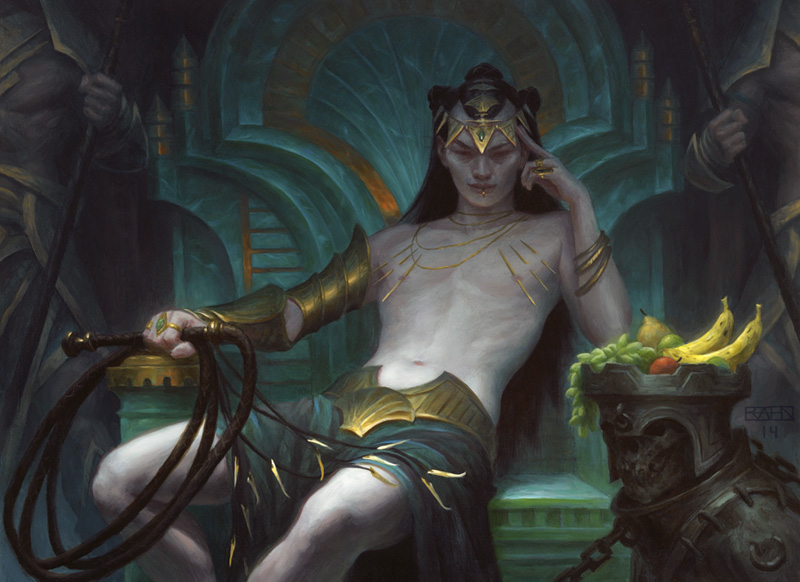
(Art by Chris Rahn)
H: Damn. I hope Wizards is planning to publish a Tarkir cookbook, because I’d love to get their Sultai cheesecake recipe. Tasigur is the khan of the Sultai, a cruel and hedonistic clan of necromancers, and he looks like he knows how to have that kind of a good time.
Seriously, though, I love this art. The lighting emphasizes Tasigur’s body lines, which draw your eye up to his face. The lines have to be strong enough to pull your eye, yet be relaxed enough to convey the languor of a pampered Sultai prince.
Meanwhile, that face is incredibly complex for art that’s the size of a postage stamp: half-calculating, half-bored, Tasigur looks like the hardest thing he has to think about today is whether the exotic death he has planned for you will be entertaining enough.
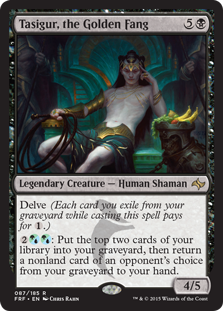
From a mechanical perspective, the worst we can say is that Tasigur doesn’t really look like a 4/5, but I can give a pass to art that depicts shamans and wizards. Presumably, when it’s go time, his magic takes care of that attack and defense. And besides, the whole point here is that he looks spoiled—but there’s an unmistakably threatening tone to the art, and that gets reflected in the power of the card itself.
I also love the visual callback to Dutiful Return. Take note, Ikea: Tarkir has some innovative endtable designs.
C: There is some excellent lighting in this image, which makes the zombie “table” all the more unsettling, since it doesn’t jump out at you—it just sits there, offering you fruit, quietly brooding on which part of you it wants to eat. Fantastic. The fruit is a nice touch, too. Something we find so wholesome and appealing is highlighted next to someone who is certainly not wholesome, and yet who is also appealing. The tension between the two is subtle, and heightens the sensuality, since we are invited to partake with all our senses of this perverse blend of life and death.
Speaking of perverse, the lighting particularly draws you to Tasigur’s groin and the whip grazing his thighs. His indolence is visually inviting—see how the lighting low in the frame draws your eyes up his body to his cruel expression?—but emotionally jarring (is that a whip? Are those piercings in his chest? And finally—what is he thinking of doing, exactly?). Sexuality here bleeds into the uncanny, which is very effective for a black card.
I’m interested to know if Wizards thinks the most attractive men are moon-pale and consort with undeath? I’m talking also about Rakish Heir, another half-naked dude with less color than this year’s Oscar nominees. Decadent necromancy does probably give one a rather casual attitude about other taboos, i.e. nakedness, but in the future I do hope to see other kinds of bodies put forth as sexually appealing. Personally, I find Shu Yun far more attractive.
Alesha, Who Smiles at Death
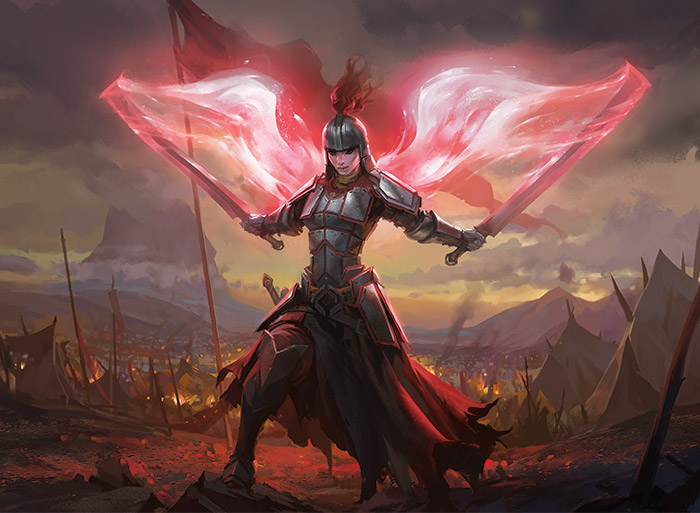
(Art by Viktor Titov)
H: This art here is actually the art for the card Mardu Runemark, but I’ve used it here because it’s good hi-res art of the Mardu khan, Alesha. The Mardu are basically the Mongol horde of Tarkir: nomadic raiders, mounted archers, and so forth. They strike fast, conquer, and move on.
I have to say, I think the character design here is a bit underwhelming. There’s just not a lot to fall in love with. That said, it’s plain, which suits a simple nomad, and built for function over form. The latter part I can get behind: this isn’t armor made to make Alesha look sexy—it’s armor built for war, and she uses it because she’s a warrior.
C: Yes, Alesha is a bit typical. But her strong pose and excellent armor (both in its design and its lack of emphasis on her boobs) are worth praising, since I think they do give her more personality. Her swords are another feature I like, given their unusual shape and the way that their implied motion creates fiery wings for her.
It’s the details that make her better than your average Posing Fantasy Heroine, but those details are not featured. Sometimes it’s okay for art to be subtle, but this is Red, which is about as far from subtle as you can get. The entire thing is tinted red, too, which makes everything blander. Tasigur has great use of lighting, and this card could really use that kind of emphasis to highlight its strengths.
One more nitpick: do these guys ride horses? Because if so, her greaves are going to cut up her horse’s flank something awful.
H: Yeah, ouch. The Mardu are big on horses, though they don’t all ride. Cool shape on the armor, but maybe a miss for this particular character.
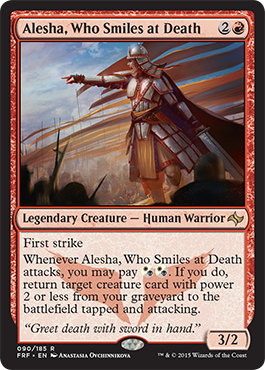
H: As far as the art on Alesha’s card itself goes, again: it’s plain. If you took away the frame, this could be a lot of different warriors—even a spell to rally your creatures. With the art of the other khans, you know that person is important.
That said, this art has some stuff going for it. In particular, I really like the posture. The arm outstretched, barking orders—this is a woman who commands her clan, and we get a sense of their respect for her. It’s functional, like the Mardu; no time for poses, we’ve got territory to invade.
C: I agree. Not much more to add, since it is a little bland as well.
Yasova Dragonclaw

(Art by Winona Nelson)
H: Speaking of poses. Yasova is the khan of the Temur, who survive in the harsh wilds of the northern mountains and frozen steppes. They mostly keep to themselves, when they can, and test themselves by surviving the elements.
I want to like this art more than I do. I’m a big fan of Winona Nelson; she did solid work with Chandra, Pyromaster, and particularly killed it with her Innistrad artwork—I love the defiance in Sharpened Pitchfork. This is a bit too tame for me, too static.
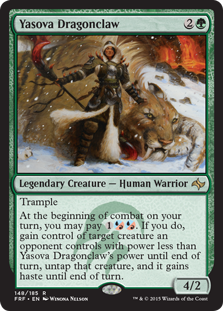
I also feel the cat draws too much focus, but it does help to tie in Yasova’s card mechanics, since she can take control of creatures. You can also read it as neat foreshadowing of the way the Temur clan will develop. In Khans, the Temur occasionally fight alongside animals, and often evoke animal strength and anger in battle—“awakening the bear,” as they call it, which is an unfortunate name but a cool idea.
C: Yasova’s card is all about texture—the lushness of fur, the harshness of her armor spines, the icy pack of snow, the molten smoothness of her weapon. Even the planes of her face are very distinct, showing the cold-beaten redness and the angles of her determination. She’s clearly saying that the tundra may be texturally inviting, but don’t touch unless you want a giant…uh, claw-halberd in your gut.
So what is that thing? I’m not sure, and I’m not sure it’s a terribly effective weapon, but I guess it’s possible. I don’t love it, but it does have to be more rugged than the others’, so we can’t get something as gorgeous as the amber mace.
Also, what, exactly, are her boobs doing? It may be because her furs are so bulky, but it looks like they’re way out of proportion to her chest, and too far off to the sides. Also, having a circular piece of metal between your breasts, even with layers of fur, is not comfortable or safe. Wizards, please, I implore you, stop trying to kill your female characters via their boobs.
All told, this is far less typical art than Alesha’s, and I find it much more appealing than Harry does. It’s not perfect, but I think that the sprawling saber-tooth is a means of conveying her ability to work with nature rather than conquer it, green’s strong point.
H: What disappoints me is that Wizards missed opportunities to make Yasova look like a badass. Consider the future Temur khan, Surrak Dragonclaw. His card art is so-so:
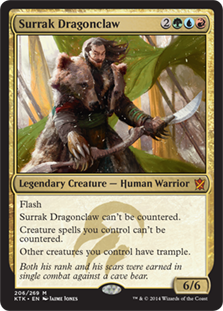
But they also took time to develop his character further on other cards.

Now that tells you something about him.
C: I’m not sure I want to see Yasova punching that saber-tooth in the face, but yeah, something more dynamic would be nice now that you mention it. Maybe playing with it like a kitten? Ah well.
H: Fate Reforged is a smaller set than Khans, so there are fewer card arts, period. So I can’t be too upset. I wish we could have used just one to make Yasova look this cool, though.
That’s it for this week! Join us next week as we take a look at some of Magic’s recent planewalkers. They’re like player characters, but for Magic!
Let us know what you think about the arts (and our analyses) in the comments. Are there any details we missed? Any hot takes we should take into account? And feel free to request particular topics in the comments—there’s lots of Magic art out there, and even more fantasy art.
- (All art copyright 2015 Wizards of the Coast unless otherwise noted.)
- (Art by Viktor Titov)
- (Art by Winona Nelson)



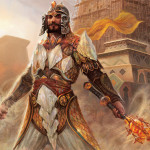
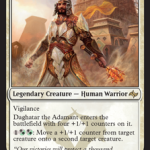

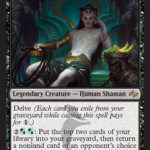
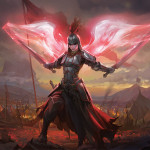

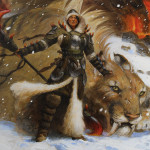
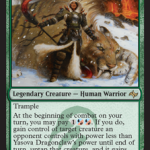
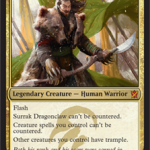
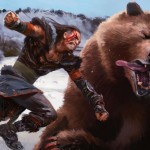
One comment